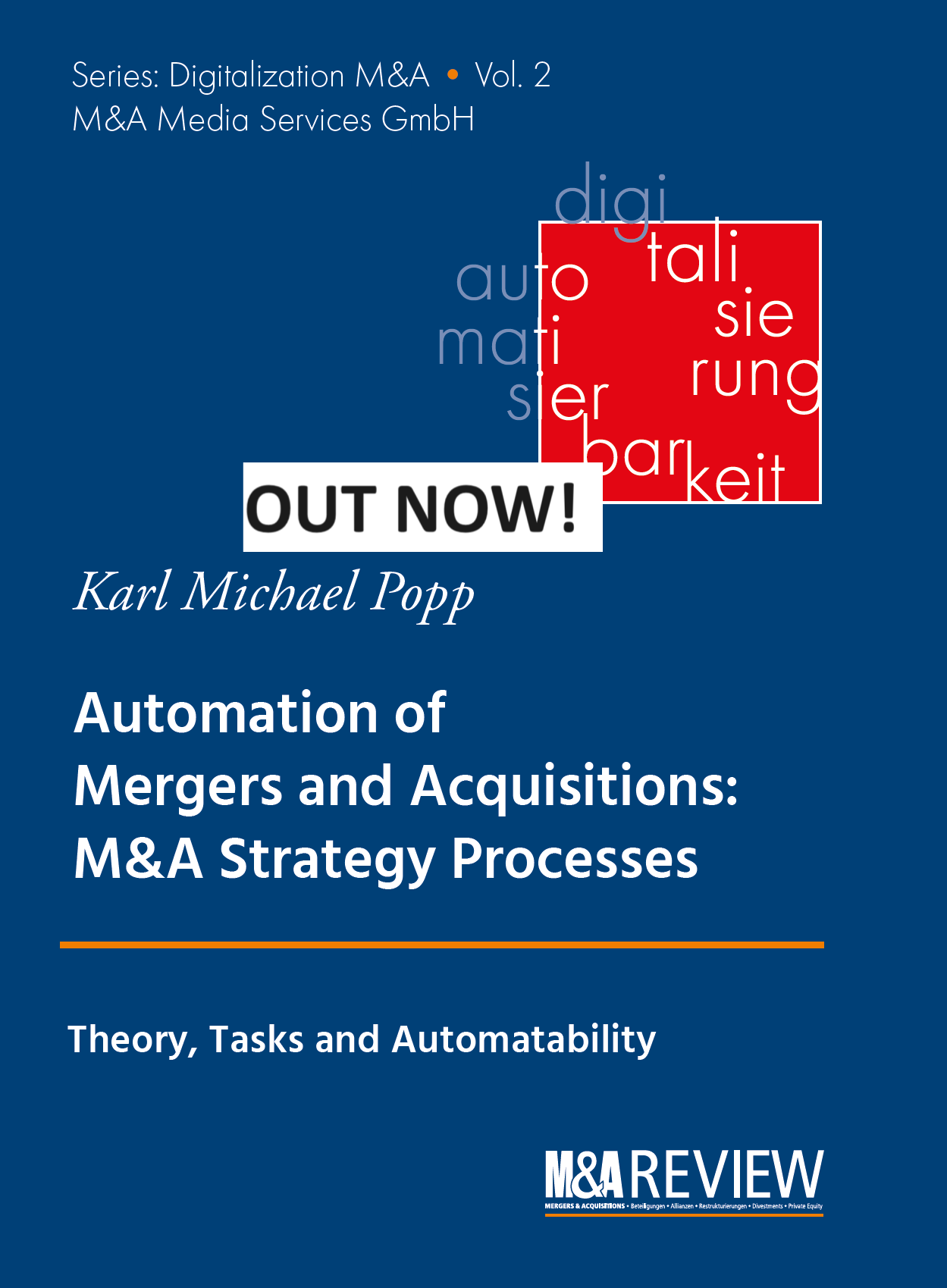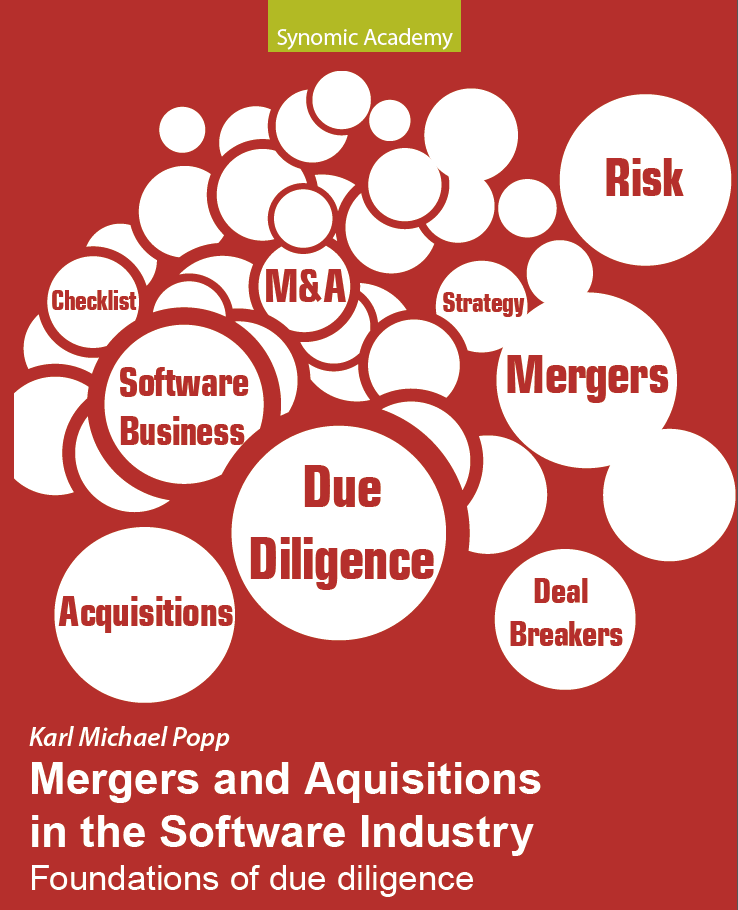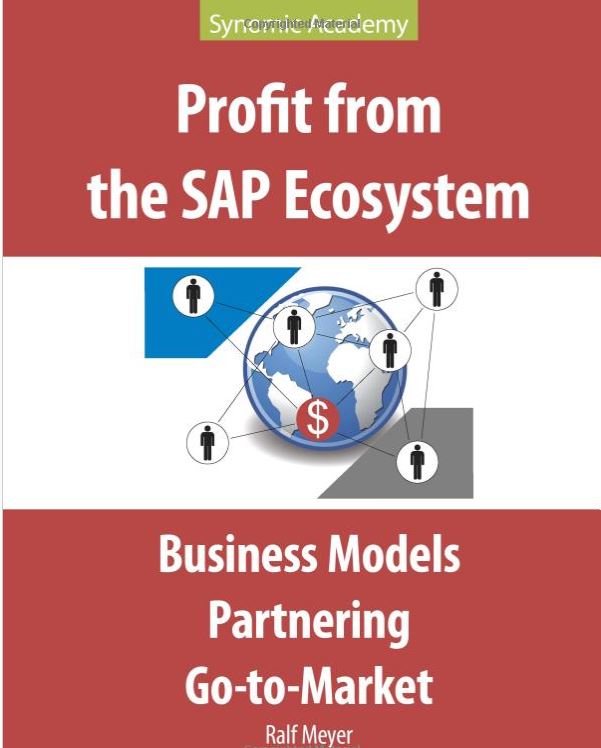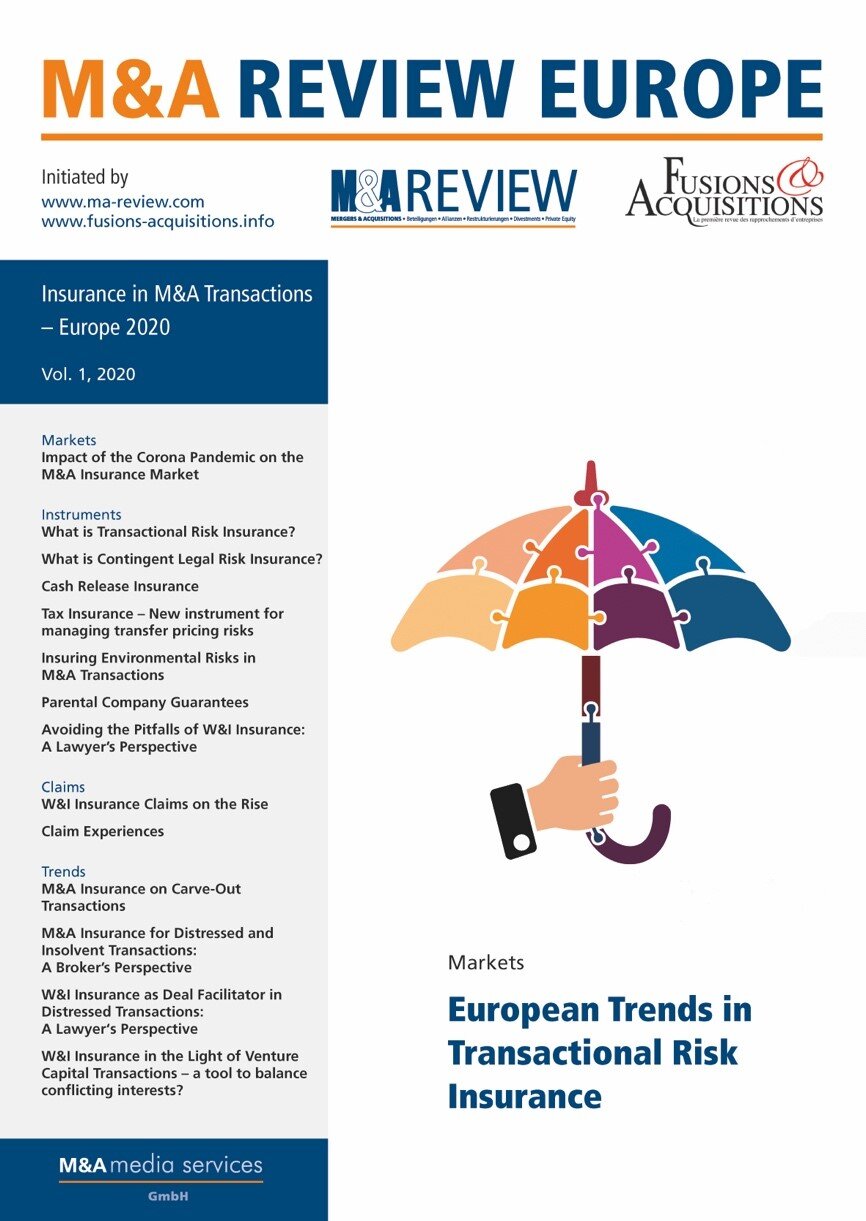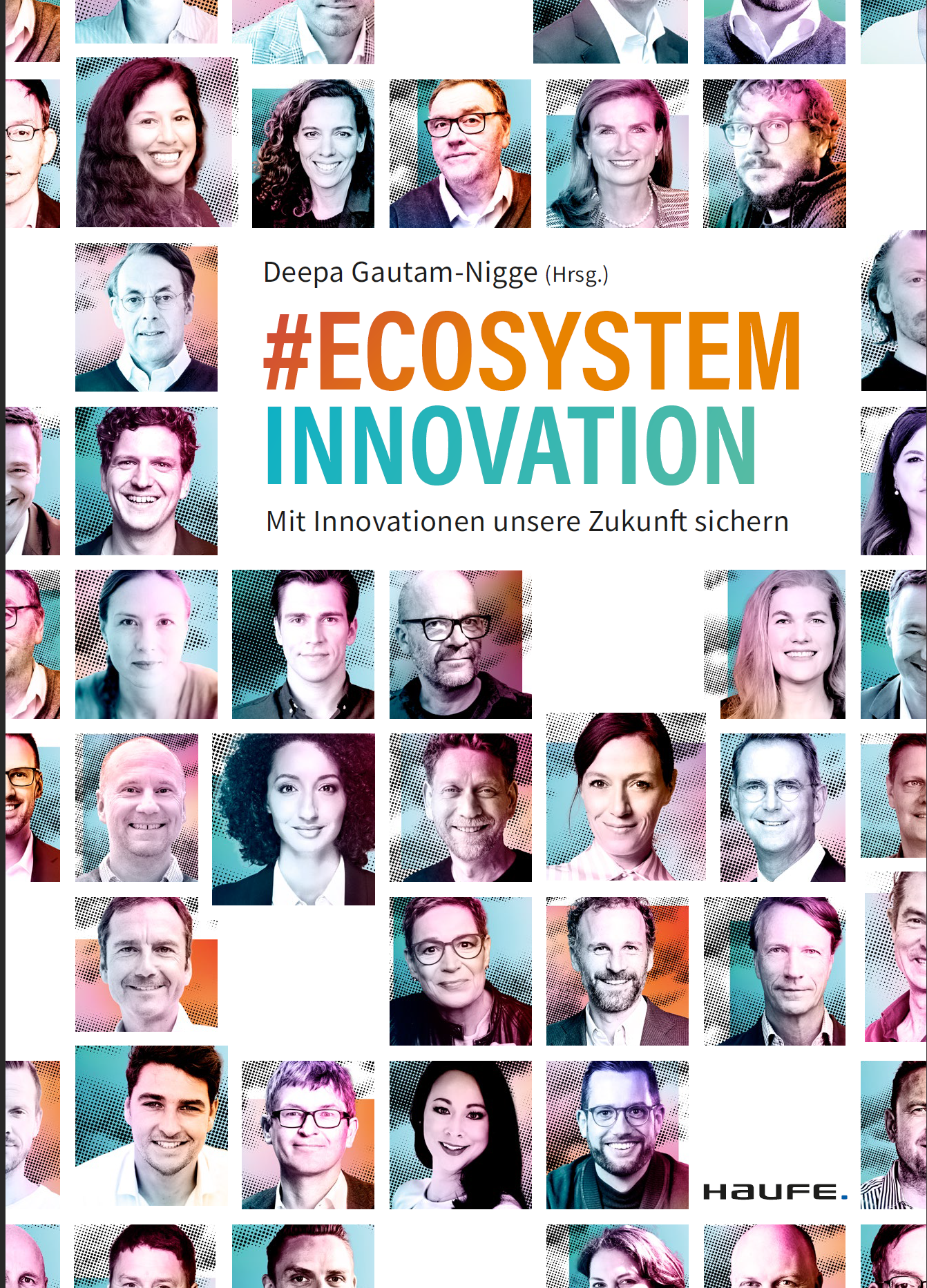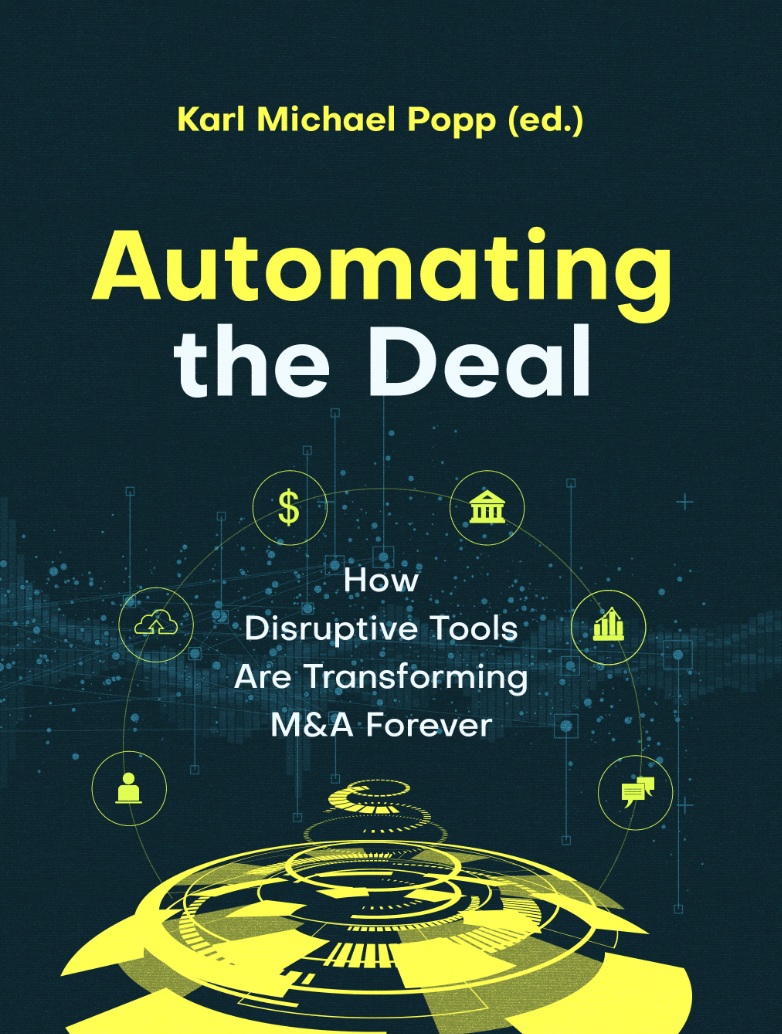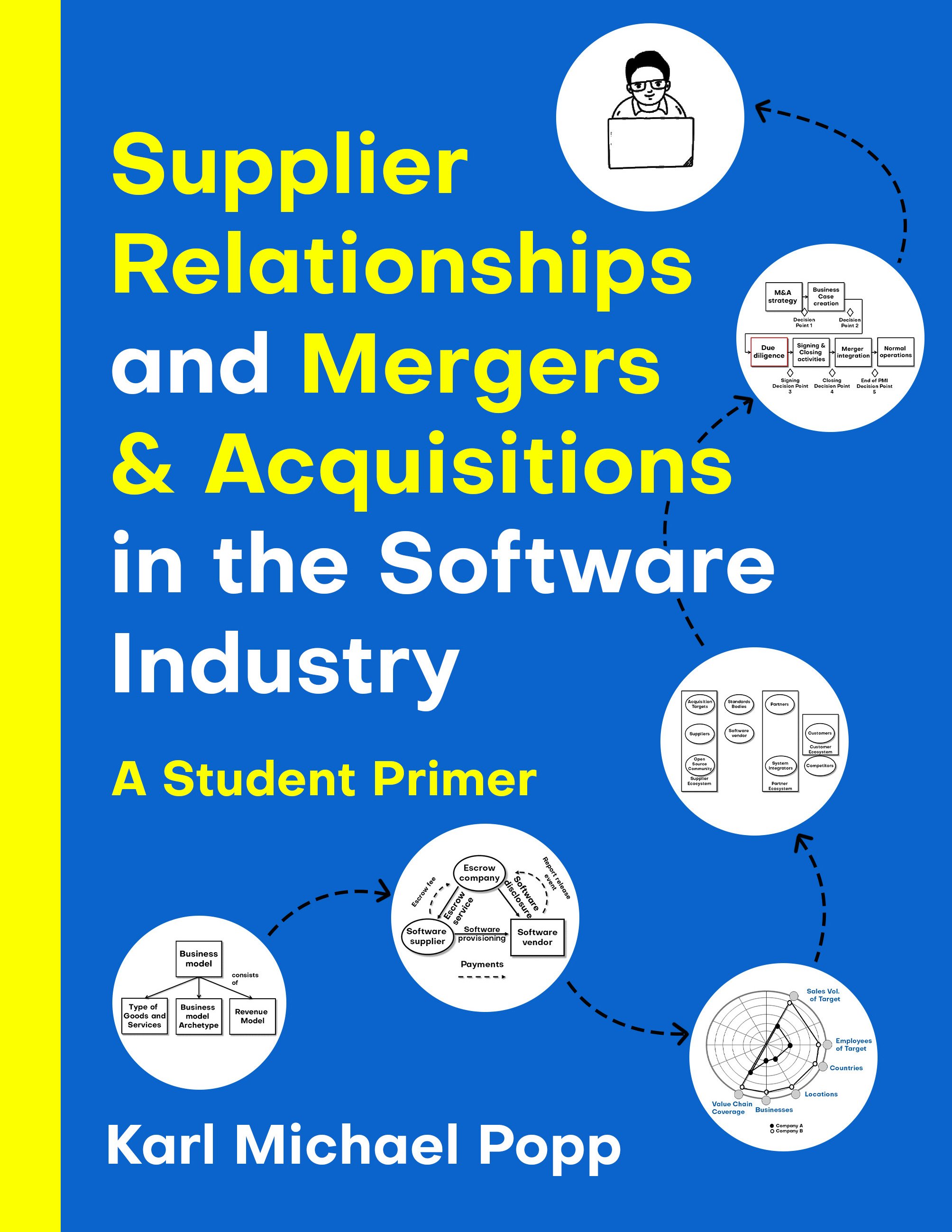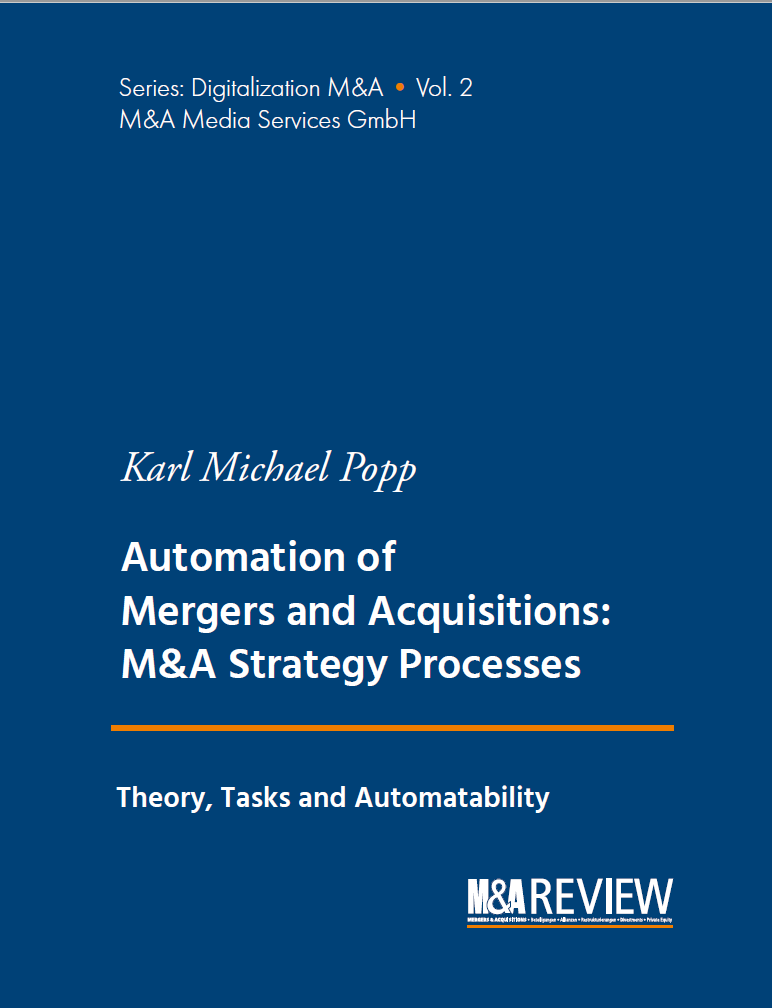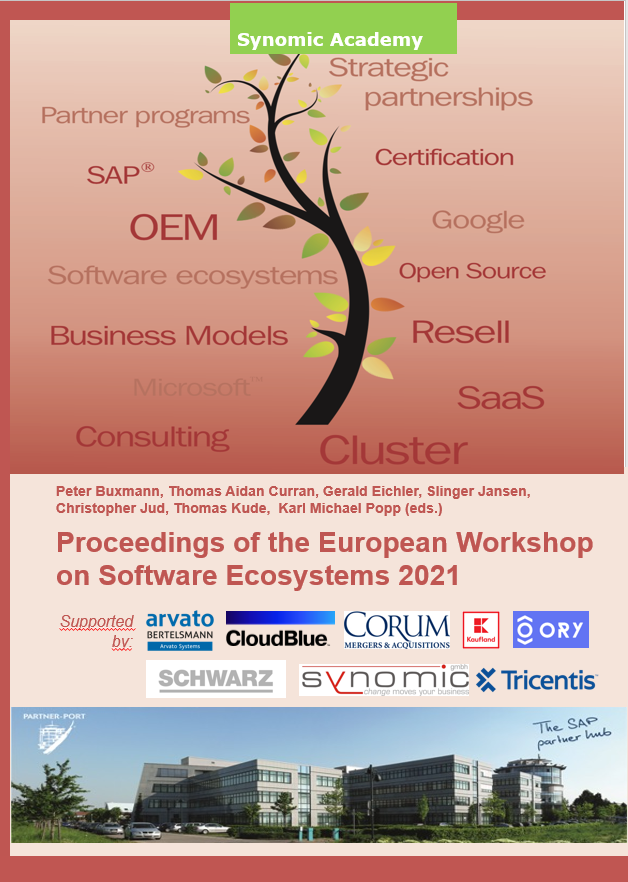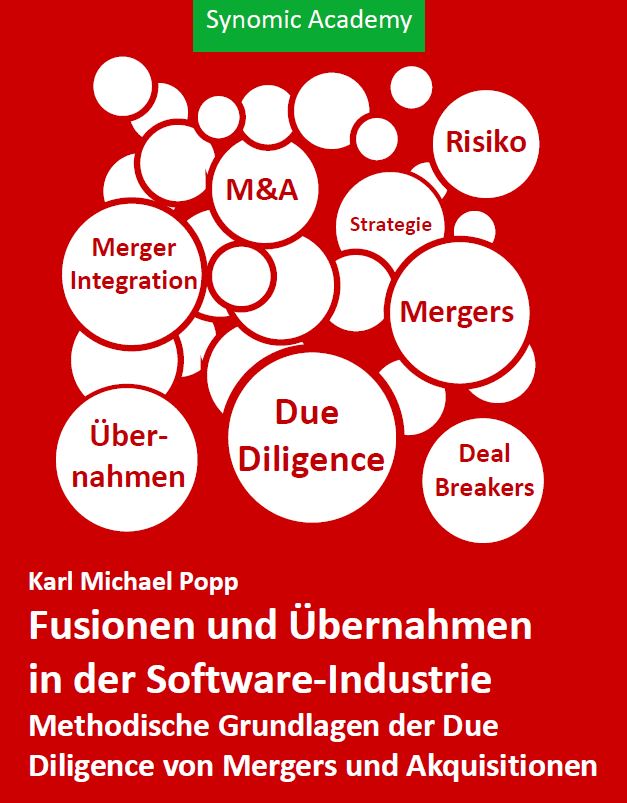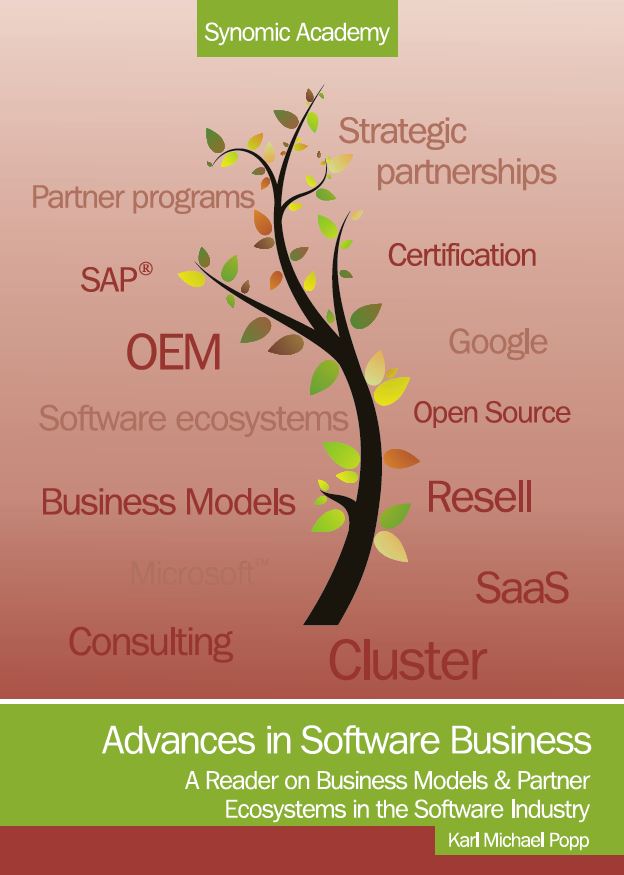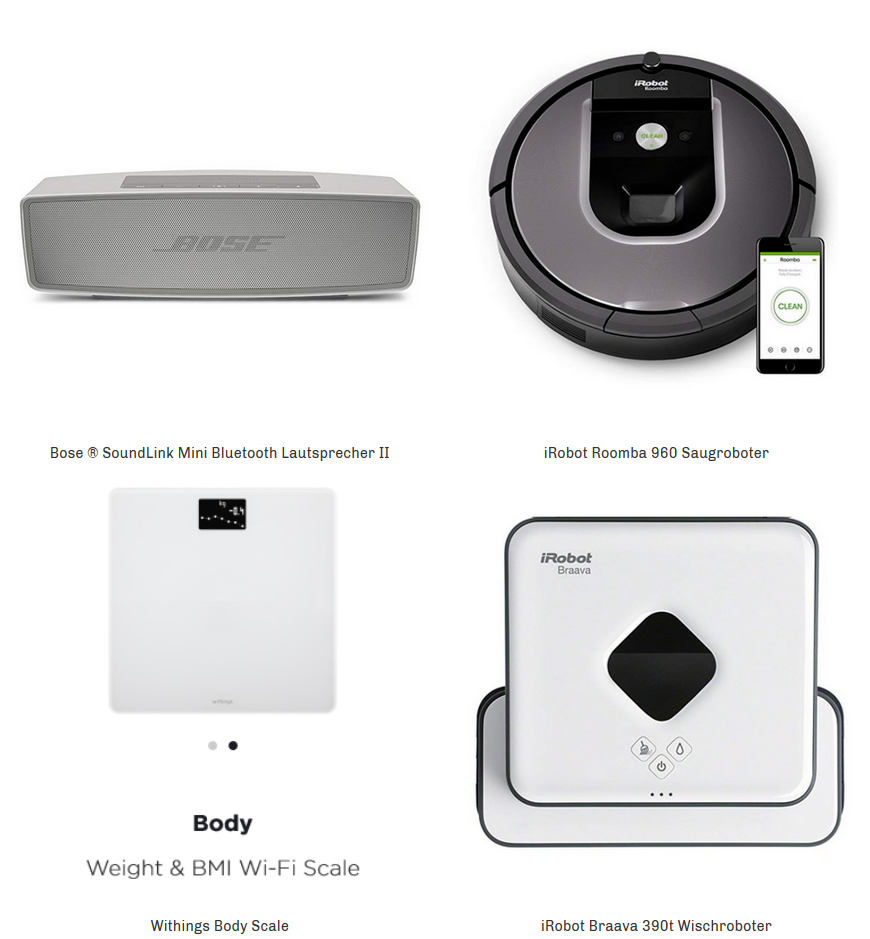Due-Diligence of the target strategy - can it be automated?
Due-Diligence of the target strategy
Why a task definition?
To enable digitization, we have to define tasks in the M&A process in detail. We use goals and objectives, a description of the task and data objects used by the task. In addition, we list questions used during execution of the tasks to provide more context. In addition we can have a look at the automatability of the task and the automation in practice. That will show us the automation potential we have today. More details will be published in my new book “Foundations of digitization for M&A processes: The Due Diligence Phase“.
The task has the following objective(s):
Target strategy: analyzed
The task has the following formal objectives:
Information asymmetry: minimized
Quality: maximized
Automation capability
This task can be partially automated. However, there are only a few actions for which tools are available. Since strategies today are usually not managed and updated in application systems, automated analysis and evaluation is difficult.
Task description
While in the current German literature under strategic due diligence the market analysis and the evaluation of potential commercial synergies dominate, the market analysis and evaluation in our approach is carried out in the GTM due diligence. Here, a different approach for strategic due diligence is to be taken. The core of the considerations is exclusively the strategy of the target. Assumptions, strategic goals and measures are determined and analysed. The relationship between the business model and the operations model is considered. In comparison to the buyer strategy, the complementarity of the target strategy with the buyer strategy is established. Any strategic risks are identified and evaluated.
The task works with the following data object types:
Target Strategy, Strategic Goal of the Target Company, Strategic Measure of the Target Company, Assignment of Strategic Measures and Goals of the Target Company, Hierarchy of Strategic Goals of the Target Company, Strategic Risks of the Target Company, Strategic Assumptions of the Target, Buyer Strategy, Strategic Measure of the Buyer Company, Assignment of strategic measures and objectives of the buyer company, strategic risks of the buyer company, strategic assumptions of the buyer, strategic objective of the buyer company, hierarchy of strategic objectives of the buyer company, draft of the strategic integration plan, strategy, complementarity of the strategy, strategic synergy.
You will find more content here:
Neues Buch: Methodische Grundlagen für die Automatisierung von M & A
M&A-Praktiker brauchen Lösungen für folgende Probleme in Bezug auf die Digitalisierung von M&A-Prozessen:
Es ist unklar, was genau zu digitalisieren ist. Welche Aufgaben gibt es, sind diese automatisierbar und auf welche Weise sind diese zu digitalisieren?
Das Digitalisierungspotenzial im M&A-Prozess ist unklar. Welche Aufgaben kann man digitalisieren? Das Digitalisierungspotenzial besteht in der (Teil-) Automatisierung von Aufgaben, die heute nicht automatisiert sind.
Die Digitalisierungsmöglichkeiten sind intransparent. Welche Tools sind verfügbar, um einzelne Aufgaben zu digitalisieren?
Diese Problemfelder werden im hier vorgestellten, neuen Buch adressiert und Lösungen aufgezeigt. Es enthält die wesentlichen Grundlagen der Digitalisierung von Mergers und Acquisitions.
Grundlagen der Digitalisierung von M&A
Ein neuer, neuer Ansatz für die Due Diligence.
Vollständige Spezifikation aller Aufgaben inkl. ihrer Ziele und Automatisierbarkeit.
Geschäftsmodellgetrieben. risikobewusst, frühzeitige Integrationsplanung.
Passend für alle Branchen.
Best Practices, die auf vielen Akquisitionen basieren.
Was ist grundlegend neu in diesem Buch
Es wird eine Geschäftsmodell Due-Diligence eingeführt, welche sich mit dem Geschäftsmodell des Targets und dessen Verträglichkeit mit dem Geschäftsmodell des Käufers beschäftigt.
Es wird eine Operationsmodell Due-Diligence eingeführt, welche die Umsetzung des Geschäftsmodells mit Hilfe von Ressourcen in einer Organisation betrachtet. Ressourcen können Mitarbeiter, Maschinen oder Rechner sein.
Es wird eine neue Form der Strategie Due-Diligence eingeführt, die sich mit der Strategie des Targets und seiner Verträglichkeit mit der Strategie des Käufers beschäftigt.
Bereits in der Due-Diligence werden Pläne für die Merger Integration einer Prüfung in Form einer Merger Integration Due-Diligence unterzogen.
Sach- und Formalziele für alle Aufgaben werden definiert.
Einbeziehung von Anwendungen in die fachliche Due-Diligence statt nur in die IT Due-Diligence
Zum ersten Mal wird der Versuch unternommen, ein vollständiges Datenmodell für die Due-Diligence zu beschreiben.
Somit haben Sie alle Grundlagen der Digitalisierung von Mergers und Acquisitions in einem Buch.
Klicken Sie, nennen Sie Ihre Adresse und ich schicke Ihnen das Buch versandkostenfrei für 49 Euro zu.
M&A digitization: A first glimpse of the domain model
The domain model will consist at least of the following parts:
A data model that shows the data objects that are involved in M&A transactions and processes.
A Hierarchy of tasks in different phases of M&A Processes.
APIs for data objects and tasks.
The domain model is a programmable model. This means it is available electronically and can be navigated and displayed as you wish. It is implemented in a set of Prolog facts and rules.
Here is a first view at the phase Due Diligence. It consists of the tasks Target Due Diligence, Integration Approach Blueprint, Merger Integration Due Diligence, Deal Making and Finalize and Approve Due Diligence Business Case. Each tasks will be documented by its goals, the data objects used and a task description.Each of the data objects will be also represented in JSON notation as well as an API documentation.
Here is an example of the documentation of each task. The task Review Merger Integration Project works on concepts
Integration Project Plan, Integration Budget, Stakeholder, Integration Success, Integration Project, Integration Project Resources.It has the goal (that describes the result):
Integration project: tested and verifiedand the objectives, which describe the qualities of the result:
Integration success: maximized Quality: maximizedIt has the following task description:
We review the structure and behaviour of the merger project. It is important to remember that the word "project" means that we have a professional management of integration by professional project managers who are experienced with complex projects and equipped with the skills of a certified project manager. We should also set up a project steering committee that has comprehensive competencies and can make decisions quickly.The word "project" means that we have a project structure plan with tasks to be performed in the project. Buying companies that make frequent acquisitions have a project structure plan template that they adapt to each of the new merger integration projects. This ensures completeness and also allows a correct assessment of whether we have sufficient resources and whether the resources know what to do in the merger.But we also focus on providing answers to questions like: Do we have the right resources for the integration tasks in mergers? Are the resources able to perform the tasks assigned to them? Do the resources have adequate social skills to guide people and convince them to integrate?So stay tuned for more information. One of the next blogs will talk about programming on top of the domain model.
The future of Mergers and Acquisitions - Digitization for M&A processes
The future of M&A
Assuming the highest possible degree of automation and integration of the tools, the following can be assumed: Routine activities will be largely fully automated, decision tasks will be partially automated, negotiations will be supported by digital assistants.
Effects of automation
Let us look at exemplary effects of this scenario for the approach in due diligence. Routine tasks such as data room review and reading of large numbers of documents will be eliminated by using natural language processing and forensic tools. Missing information is automatically requested based on consistency checks of the data room contents. The time and effort spent on this will be dramatically reduced. Problems that today can only be detected after a time-consuming, manual review of the data rooms are automatically determined and displayed as soon as the data room is available. In other words, these issues will be available on day one instead of weeks later.
Remaining questions regarding the content of the data room are answered with the help of chat bots. The contents of due diligence meetings between buyer and target companies are also automatically logged and matched by digital assistants with the contents of the data room and the information received in the meeting, as well as e-mails and other information, are automatically added to the due diligence knowledge base.
Benefits of merger automation
There may be many other effects of automation that are not listed here. This future scenario would have the following benefits: The quality of the due diligence results will increase because the due diligence information is fully captured and does not depend on human resources. The risks and problems available at the beginning of the due diligence phase due to automation can be analyzed and mitigated earlier and more thoroughly. This can be used to increase the quality of results or to significantly shorten the due diligence process.
This short example has given us a first insight into the expected, far-reaching effects of automating the due diligence process. Whether and how quickly we will arrive in this future is up to all of us. The human factor will still be decisive, but in a different form. Let us proceed optimistically.
The future of M&A interview
I have talked about this in an interview with Kison Patel, that you can view below.
The future of M&A
A new approach to merger automation is needed
This is why we need a new, radical approach to digitization of M&A processes. This approach is described in detail in my new book. For more information and free previews, sign up here: (we respect data privacy and will not spam you. You will get M&A- and book-related content)
Here is some interesting literature on the topic:
Digitization potential for M&A processes - more details
Details on the digitization potential in the M&A process
Let´s dig into this. First we need two terms: Automation potential and automated integration potential.
Automation potential
An automation potential for an individual task exists if the degree of automation of the solution process is lower than the automation capability of the solution process. The same applies to task coupling.
Automated integration potential
An automatic integration potential for a sequence of tasks exists exactly when the tasks are not assigned to one or more different automatic task carriers. This means that there is no integration potential for a sequence of partially automated tasks that is assigned to exactly one automatic task organizer. This sequence of tasks is integrated at most automatically.
Digitization potential
Now we can define the digitization potential. A digitization potential for the M&A process consists of the automation potential of all tasks and the automated integration potential of the process.
Current situation regarding digitization in companies
The current situation in many companies is as follows. There is a high level of personal integration for numerous tasks in the M&A process, since many tasks are assigned to exactly one team, the M&A team. There is a lack of automation of the individual tasks and even more so a lack of end-to-end, automated integration in the M&A process.
A new approach is needed
This is why we need a new, radical approach to digitization of M&A processes. This approach is described in detail in my new book. For more information and free previews, sign up here: (we respect data privacy and will not spam you. You will get M&A- and book-related content)
Here is some interesting literature on the topic:
Great keynotes for EWSECO April 23 2020 Growth strategies for platform ecosystems TICKETS ON SALE
B2C Platforms like Amazon or Alibaba have all the hype and all the envy. But how does a company create, build or run platforms, business networks, a company in the API economy? answers here:
We have exciting news, the workshop draws massive attention and attracts keynote speakers, sponsors and more:
Keynotes
One keynote speaker is Rolf Schumann, Chief Digital Officer of Schwarz Gruppe. He will talk about enriching the customer experience in retail B2C business networks.
The second keynote speaker from ORY Systems GmbH will give a keynote about using open source to create a successful innovation platform.
BUY Tickets
Sponsors
The Schwarz Group, headquartered in Neckarsulm, Germany, owns the companies Lidl and Kaufland and is Germany's largest retail group with a group turnover of 90 billion euros. Its activities are divided into discount food markets under the name of Lidl and hypermarkets and hypermarkets such as Kaufland, KaufMarkt, Concord and Handelshof. Today, Lidl stores are located in almost all European countries. Lidl is currently represented in 26 countries, Kaufland in Germany and in six other countries.
ORY´s mission is to help make the cloud more manageable, useful and safe and to give developers access to infrastructure and services that makes developing for the cloud easier. We consider it a privilege to be able to help developers push the boundaries of modern cloud technology. ORY is the open source and cloud native identity infrastructure. ORY is written in Go and open standards and consensus are the foundation. It is language and platform independent, extremely lightweight, starts up in seconds and doesn’t interfere with your code.
About the workshop
The program committee would like to invite European researchers and practitioners in the field of software ecosystems, platform ecosystems and business networks to come together in Heilbronn, Germany, on April 23rd 2020, to discuss recent (academic) research and recent business experiences and lessons learned, insights or issues related to management of ecosystems, business models or technical issues including but not limited to topics like
Software ecosystems
Research progress and new knowledge for software ecosystems
External forces - the new normal and the impact on software ecosystems
Business networks
Business networks vs. platform businesses
Business networks as platforms for transaction, innovation
Growing business networks by extending beyond participants
Platform Business Models
Types of platform business models for transaction, innovation
“Platformizing” existing businesses - how to be successful?
Business model innovation resulting in a platform business model - how to make it work?
Architectures and APIs for platforms
Growth strategies based on platform ecosystems and business networks
Growing by acquiring a platform business
Digital platforms and businesses
data-driven and analytics ecosystems
We will invite practitioners to the workshop to ensure discussion about the practical impact of research and to give the presenters the opportunity to discuss with practitioners and researchers alike.
The workshop location at City Campus in Heilbronn, Germany, with many software and software service companies having an office nearby which eases the participation for practitioners.
BUY Tickets
Workshop style
Socialize and discuss with (academic) researchers and fellow professionals.
We value discussion as well as presentations. So a short, 15 minute presentation is followed by 15 min discussion with fellow researchers and practitioners.
The workshop will be held in English language only.
Poster session
As a new feature of the workshop, we are offering a poster session. If you are interested to present your work in progress to practitioners and fellow researchers, please submit a title and abstract as stated below, mentioning that it should be a poster session.
Submissions
Propose your presentation titles or poster proposals via email (title and 100 word abstract) to ewseco17@software-ecosystem.com
Submission deadline is March 30th 2020 6pm CET.
Digitalization of M&A: how the job to be done forces a new generation of tools
REQUIREMENT: M&A PROCESS TOOLS HAVE TO BE NON-INVASIVE AND HAVE TO RESPECT THE WORK ENVIRONMENT OF THE M&A PROFESSIONAL.
What is the job to be done? The job to be done is a concept invented by Clayton Christensen in his book "Competing Against Luck: The Story of Innovation and Customer Choice". It is a new way to look at the needs of customers and why they are "hiring" a product to fulfill their needs. The key concept is to focus on the customer and to avoid the viewpoint of the product. By doing so, you get a wider view what the needs of the customers are, what the customer should hire to help him and who your real competitors are.
How does it influence tool design? As soon as you know the job to be done and the context of the customer, you are able to design a product or service that has maximum value for the customer. As mentioned in an earlier blog, the context of an M&A professional is his office, the work environment on his desk, his smartphone, desk phone and computer. An M&A process platform must respect and enhance this work environment, not add another tool. So let us use this approach to define two requirements for M&A process tools.
From tool to pain reliever: One pain i heard most from fellow M&A professionals is to fill the same data like target valuation data into several different Powerpoint presentations which have different formatting but basically should reflect the same data. So an M&A platform must store the financial data of a business case and generate data into different powerpoint templates. An end-to-end M&A process platform should have a data management component for the financial data of the transaction that can intelligently export parts of the financial model into presentation formats.
From tool to productivity boost: assistive technology helps you to perform better. The pain of the M&A professional is that he has to research market and company data, bring them together and evaluate the opportunities. How can an end-to-end M&A platform help here? Market data feeds are provided automatically for business case creation. The platform offers research as a service data feeds to accomplish that.
Summary
End-to-end platforms supporting M&A processes are the basis for the digital future of M&A processes. The job-to-be-done approach helps to define service of these platforms. These value creating services, which are built on top of this platform, help M&A professionals to get their job done.
Digitalization of M&A processes: How to integrate best of breed solutions into one M&A process platform
Requirement: We need a metamodel of end-to-end M&A processes and objects
We have to move forward quickly to disrupt existing M&A processes and get the best innovations to get to a digital M&A process. So here are my thoughts, some might be drafty, but i want to get my requirements out now to ensure we all are facing the right direction for digital M&A.
Requirement: we need several vendors to provide innovations
Can the best innovation for all phases of M&A come from one vendor only? Probably not. So how do companies get the best functionality in a unified, end-to-end M&A platform? The platform has to be open, has to have OData based APIs to allow integration with the best of breed functionality for the different phases of the M&A process.
Requirement: We need a metamodel of end-to-end M&A processes and objects
Thirty years of object modelling for businesses are paving the way to create a metamodel of M&A processes. This metamodel should contain the objects and relationships to be used in the M&A process like buyer, target, companies, which are contained in longlist, shortlist, have relationships with data rooms, documents like contracts, patents, financial data etc. etc. In addition we need
Requirement: Standardization is needed
Establishing a standard metamodel for end-to-end M&A processes is key to success. There are three ways to establish it: via the market or via standardization committees or by creating a winner takes it all market for the end-to-end M&A process platform. it will be interesting to see which vendor chooses which approach.
Requirement: An ecosystem of extensions of the end-to-end M&A process platform
Based on the standardization and the OData-based metamodel, M&A process platform vendors can start to foster an ecosystem of innovations for the M&A process. Today, we would need e.g. the following ecosystem of vendors to engage: end-to-end M&A process platform, data room vendor, company information providers, contract analysis providers, machine learning application providers etc.
Summary
With the listed requirements in place, we can move forward quickly to leverage innovations from different vendors. From my point of view, establishing a winner in the end-to-end M&A process platform market is paramount to provide massive innovation to many companies. Several large corporates in Germany are considering to choose such an M&A process platform today to streamline their operations. I will keep you posted if there is one vendor that wins the market or if there are several vendors fighting for larger marketshares at customers.
Like my way of thinking? So feel free to read my book about M&A: M&A due diligence in the software industry. Do also feel free to comment, happy to receive the feedback.
Building on the shoulders of giants. Shortcuts to Platform Business Success
Platform business
Say, you want to start a new two-sided platform business. This blog is about jumpstarting platform businesses from scratch by leveraging other platform
Gravity
Gravity is the number of participants you have on both sides of your platform. Gravity on each side of the platform is a key prerequisite for platform success. Platform success is dependent on gravity because the direct and indirect network effects for the participants of the platform depend on gravity. So how do you create instant gravity?
Usually, companies run advertising campaigns and start recruiting participants on each side of the platform. Under this approach, the focus should be on getting participants with high gravity. High gravity means that they are large companies or they bring their ecosystem on to both sides of the platform to massively increase the number of participants.
One example is SAP Ariba. It is a two sided platform with corporates on one side and suppliers of goods and services on the other side. When they added Rio Tinto on the corporate side of the platform, Rio Tinto brought in thousands of their suppliers and thus created massive gravity on the supplier side, too. So this is one reasonable approach to add gravity.
Free but paid with information
Another approach to create gravity is to offer free functionality on one side of the platform, but charge on the other sides of the platform. Perfect examples are Google and Facebook. Consumers are not charged, but they pay with their data. The price of zero for consumers has the potential to attract many consumers and creates gravity.
Leveraging the gravity of other platforms
Why should a platform company at all start to create gravity from scratch on their own? A new approach i am proposing is to leverage gravity of other platforms for your own platform. The idea is to combine other platforms for your success by building on top of them.
Examples: SAP acquired Coresystems. Coresystems had a crowdsourcing platform for field services, i.e. maintenance and repair scheduling. To get more gravity, the solution was integrated with SAP´s marketplace for temporary workers, SAP Fieldglass, which created massive gravity for crowsourcing field technicians.
Bericht von der Denkfabrik 2019
Hier sind Impressionen vom arbeiten, lernen und netzwerken mit den Besten in den Bereichen Merger Integration, Qualität und Repositionierung. Inspirierende Vorträge und intensive gemeinsame Arbeit in interaktiven Workshops, die auf Design Thinking basieren, machten den Workshops zu einem besonderen Erlebnis.
Am zweiten Tag des Jahreskongresses Post Merger Integration des Bundesverbandes M&A fanden sich etwa fünfzig Teilnehmer fanden sich zum diesjährigen PMI-Workshop “Denkfabrik Wirtschaft” zusammen, um sich aktuellen Themen wie z.B. Digitalisierung des M&A Prozesses, Risikomanagement, automatische Vertragsanalyse, cybersecurity und Kulturintegration zu widmen. Bemerkenswert war der Veranstaltungsort: die Sportsbar des Sheraton Hotels Frankfurt.
Dr. Karl Michael Popp eröffnete den Workshop mit einem Kurzüberblick über die Agenda und leitete zur ersten Keynote der Firma Q-nnect über mit dem Titel “21st century M&A“, die sich dem Thema der IT-Integration widmete.
Es folgte die Vorstellung des auf Design Thinking und agilem Vorgehen basierenden Workshop-Konzeptes durch den Design Thinking Experten Olaf Mackert. Anschliessend brachte ein unterhaltsames warm up game die Anwesenden auf Betriebstemperatur.
Dann teilten sich die Teilnehmer in drei Workshop-Gruppen auf, die in 90-minütigen Workshops die Themen Integration der Unternehmenskulturen, IT-Integration aus Sicht der Finanzabteilung sowie Überblick über den State-of-the-Art der M&A-Digitalisierung diskutierten. Eine zweite Welle von Workshops widmete sich den Themen GET Excellence - Organisation und toolgestützte Steuerung des Integrations- & Synergien- Managements, Risikomanagement in M&A und PMI- wie stellt man Compliance sicher und ist trotzdem effektiv sowie Bewertung und Mitigation von Cyberrisiken bei der PMI.
Nach dem Mittagessen folgte die zweite Keynote des Tages von SNP mit dem Titel “BRIDGING THE GAP BETWEEN BUSINESS AND IT - ERP transformation from a M&A perspective“.Vor der letzten Workshop-Runde brachte ein weiteres Warm up die Teilnehmer in Schwung.
Die nächste Workshop-Runde war für folgende Themen reserviert: Automatische Vertragsanalyse revolutioniert die Due Diligence, Nutzung eines konfigurierbaren M&A-Referenzmodells zur Dokumentation von Best Practices, zur Steuerung des Prozesses und zur Kartierung von Tools im M&A Prozess sowie Erfolgreiche Geschäftsmodelle mit Hilfe hybrider Intelligenz schaffen.
Der Workshop schloss mit einer Feedback-Runde. Die Teilnehmer erhalten im Nachgang eine Zusammenfassung des Workshops.
Mehr Informationen finden Sie auf der Webseite des Workshops.
NEW Extended and updated second Edition of Best Practices for commercial use of open source software: Business models, processes and tools for managing open source software ISBN 9783750403093
This book enables you to leverage the state-of-the-art of creating open source based business models and of managing open source in the development cycle of commercial software and during due diligence in mergers and acquisitions. In addition, it provides information about why investments in open source makes sense.
The book has been reviewed, extended, amended and now contains two brand new chapters, one by Joseph Jacks from OSS Capital, a fund focused on investing in commercial open source companies, provides fundamentals of the open source business by elaborating on value creation and value capture for commercial open source companies. The other one is by Snyk and focuses on development aspects of using open source software as part of commercial products. The book is available with the ISBN 9783750403093. BUY ON AMAZON
Practitioners, investors and consultants created this book to help professionals in the software business like investors, executives, business developers, product managers, architects, developers, quality managers, development operations managers as well as students to get acquainted and proficient in using open source products in a commercial context.
First, the focus is on business model impact of open source products and open source licenses. Dr. Karl Michael Popp gives an overview of the different types of business models for open source companies. Dr. Josef Waltl shows how open source licenses and intellectual property strategies can create a unique business model based on a combination of open source and proprietary software.
Then, the focus is on detection and license compliance aspects of open source software in mergers and acquisitions. The acquisition of a software vendor requires the review of intellectual property rights including open source license compliance as described by Dr. Karl Michael Popp.
The following new chapter, authored by Joseph Jacks from OSS Capital, provides fundamentals of the open source business by elaborating on value creation and value capture for commercial open source companies.
Then, two chapters cover the offerings of tool vendors for governance of open source software but also for development enablement. First, Bill Weinberg and Greg Olsen show the broad offering of solutions of Black Duck Software, a provider for open source governance and enablement tools.
The next, new chapter, provided by Snyk, focuses on development aspects of using open source software as part of commercial products like assistance for developers in selection and in continuously updating open source components during the software development lifecycle.
Denkfabrik Wirtschaft
M&A Aktivitäten sind für viele Unternehmen nach wie vor eine wichtige strategische Option zur Steigerung des Unternehmenswertes und des Unternehmenswachstums. Nichtsdestotrotz ist ein Unternehmenskauf aber oftmals eine große und risikoreiche Investition und stellt insbesondere in der Post Merger Integration eine große Herausforderung für Unternehmen dar.
Es lohnt sich, dieser Phase ein hohes Maß an Management-Aufmerksamkeit zu widmen, denn nachhaltige Wertschöpfung erfolgt nicht durch den Kauf an sich, sondern durch erfolgreiche gemeinsame Integrationsarbeit.
Der Jahreskongress PMI des Bundesverbandes M&A und der angegliederte interaktive Design Thinking-Workshop „Denkfabrik Wirtschaft“ beleuchten die kritischen Erfolgsfaktoren und typische Vorgehensweisen bei der Unternehmensintegration:
Standardisierung und Best-Practices für den Integrations- und M&A-Prozess
Transformation des Integrations- und M&A-Prozesses durch Digitalisierung und
digitale ToolsKulturelle Integration im M&A-Prozess
aktuellste Erkenntnisse aus der internationalen wissenschaftlichen Forschung und Beratung im Bereich M&A und PMI aus europäischer und amerikanischer Perspektive
Die Teilnehmer des Workshops können Ihre Themen und Fragen aktiv einbringen und zusammen mit anderen Teilnehmern Lösungen erarbeiten und haben so die Möglichkeit, von den praktischen Erfahrungen anderer Unternehmen zu lernen und diese für sich zu nutzen.
Zwei kurze Keynotes runden das Programm ab. Dieses Format gibt es seit drei Jahren und es hat hervorragende Bewertungen der Teilnehmer erhalten.
Und das Erlebnis endet nicht beim Workshop, die Teilnehmer können in dem Arbeitskreis PMI des Bundesverbandes M&A weiter mit den anderen Experten zusammen arbeiten und sich austauschen.
Agenda und weitere Informationen finden Sie unter www.mergerintegration.events
Aktuelles zur Jahrestagung PMI des Bundesverbandes M&A!
Ein Update zum Jahreskongress Post merger integration
Hier ein paar Informationen zum Gesamtkonzept der zweitägigen Veranstaltung:
1. Tag des Jahreskongresses PMI: BM&A in Kooperation mit KPMG 24.10.
2. Tag des Jahreskongresses PMI: BM&A in Kooperation mit Denkfabrik Wirtschaft 25.10.
http://ewpmi.squarespace.com
Zwischen ersten und zweiten Tag gibt verbindende Abendveranstaltung durch Einladung der KPMG in Kooperation mit dem BM&A für Teilnehmer beider Tage
Die drei Schwerpunkt-Themen der beider Tage sind:
• Cultural Integration
• Best Practice Prozesse & Ansätze
• Digitalisierung & Digitale Tools im M&A Prozess
Der erste Tag wird von dem BM&A in Kooperation mit der KMPG gestaltet. Dieser Tag besteht vorwiegend aus Vorträgen.
Der zweite Tag, die Denkfabrik Wirtschaft ist arbeitsorientiert, die Schwerpunkt-Themen werden im Rahmen von Design Thinking Workshops interaktiv und gemeinsam diskutiert und erarbeitet.
How Real-Time Transparency Makes PMI Meetings Effective
As soon as the clock starts ticking, every second in a PMI project matters. Speed in M&A integration execution does bring value and it correlates to the success of M&A.
Your Integration framework is in place. Functional leads are fully armed, and at their battle stations. Ready… Set… DAY 1!
As soon as the clock starts ticking, every second in a PMI project matters. Speed in M&A integration execution does bring value and it correlates to the success of M&A. With the ever-decreasing timeframe in which integration leads are expected to realize synergy targets, there are few things more important than a structured and diligent integration plan. But when day one hits and Pandora’s box is open, being able to track the success of your plan in real time is crucial to hitting your targets.
Weekly meetings are the lifeblood of most integrations, and have been the best practice until recently. Whether it is program meetings, project meetings, or Executive Steering Comittee meetings, there are a few data points that need to be tracked consistently at a high-level.
Issues
Task Status/Milestones
Timeline
Responsibility
Classically, the integration leaders ask for updates from each functional lead/project manager, and get a verbal play-by-play of the past week’s happenings. In our current, tech-driven world, there are now digital tools that can increase meeting productivity and give M&A teams instant transparency into their processes. Integration team members can see what’s happening prior to meetings, ensuring focus on how to address issues, decisions needed, cross-stream dependencies, etc. This means that meetings’ action items are clearer, and time is spent proactively working towards targets, rather than retroactively getting updates on who did what, when.
Each of the integration performance items above are affected by the PMI teams ability to have “real-time” visibility:
Issues
Having instant visibility into the status of any potential issue enables corporate development teams to address risks before they damage the deal. Any PMI project will run up against unforeseen challenges, but proactively resolving issues leads to an increase in deal speed and value realization.
Task Status/Milestones
Many teams have thousands of tasks per integration, but there are always key milestones against which success is measured. Having the opportunity to check on the mission-critical items at a moment’s notice shortens the feedback loop within teams and empowers integration leads with the information they need to benchmark their teams against their schedules in real time.
Timeline
Let’s face it. Integrations very rarely hit timeline expectations. But, knowing where you are in relation to your goal is crucial. Having that 1-week gap in status update between team meetings might just be the difference between being on time and falling far behind.
Responsibility
PMI projects have many moving pieces in play. Governance is complex. The PMI leads manage the functional leads, who in turn must allocate resources from within their teams. Having a central platform that acts as a single source of truth is invaluable. Immediately, it becomes clear who is responsible for a task, who has signed off on what action item, etc. When there are multiple chains of command, being able to see changes in real time gives Integration leads the bird’s eye view that is needed to execute.
To quote Mark Herndon of M&A Partners, "The time has come to upgrade M&A integration management processes with simple, secure and state-of-the-art software solutions." This real-time transparency gives cutting-edge PMI teams full visibility and control in the perfect storm that is integration.
Two best practices for managing the integration project
Best practices in merger integration have to include many aspects like timing, project management, handling exceptional situations and decisions and when to end the integration project.
Best practices in merger integration have to include many aspects like timing, project management, handling exceptional situations and decisions and when to end the integration project.
In merger integration activities timing is essential. So when is the right point in time e.g. to merge teams of acquirer and target that do similar things? When is the knowledge of the acquirer complete to integrate HR functions of the acquired company? When is the right time to end the integration project?
Merger integrations are also high-risk, high effort topics that have to manage numerous exceptional situations. Project management practices are made for such projects. But there is the risk of keeping project members hostage in reporting activities instead of focusing on resolving issues and completing tasks. So a key aspect is to find the right dose of project management for keeping project control by providing appropriate follow-up and execution of critical tasks and minimizing the project management workload on project members.
Let us quickly look at the topics: “When to mix up teams working on the same topics?” and “When to declare the end of the integration project?”
When to mix up teams working on the same topics?
So when is the right point in time e.g. to merge teams that are working on the same tasks, selling to the same customers, producing similar work results? We discussed different aspects.
The first one is that the acquirer has to have sufficient knowledge about all departments or teams that have to be integrated. Without that knowledge it is impossible to plan and execute change management needed for the transition into a merged team.
The second aspect is if the time is right to integrate if the immediate value of integration is maximized or the confusion and trouble is minimized. One example is the immediate integration of finance activities for maximizing the value for the acquirer to be in control of finance. Another one is integration of sales teams to avoid having two different, competing sales teams as “one” face to the customer.
When to declare the end of the integration project?
Ending the integration project makes sense when at least one or more of the following goals have been reached:
· integration plan has been fully executed,
· benefits of the acquisition have been reached or
· organizational performance (fully functioning and stable merged organization) is ensured.
The selection of one or more of these goals depends very much on attributes of the merger, specifically on the department (or corporate function) to be integrated, on the culture of the target and the acquirer and on the integration strategy, like e.g. if the target should stay separate or should be fully integrated into the acquirer. Depending on the size of the M&A and merger integration team, the support of these teams might end earlier due to high workload or focus on new, different M&A and integration projects.
Find more information in the book “Mergers and acquisitions in the software industry” (click here for German version) and at the German Event Denkfabrik 2019
Software strategy selection: is build, buy, partner sufficient or do we have to add open source to the game?
Strategy selection
The best innovation and growth strategy is to combine organic and inorganic growth. SAP has successfully applied organic innovation and growth resulting e.g. in SAP HANA, SAP S/4 HANA as well as inorganic innovation and growth via acquisitions like Qualtrics and Calliduscloud.
Build, buy, partner
For me, the most important distinction between build or buy is the window of opportunity that you have. In technology markets, there are frequent changes of market direction. If you’re lucky, you had started your solution in time to build something that is en vogue right now. But if you’re not lucky, you need to acquire capabilities that the market needs today. But is this the only option you have?
Opportunity and risk in building and acquiring solutions
To be frank, with the current state of technology due diligence on to be acquired companies there is no difference in risk to build or to buy. When building products, you trust your developers to build something great. The a priori likelihood of success is 50%. Same likelihood applies for acquiring technology. In addition, acquired technology exists, has customers, success and failure history. So, what is the impact of this statement on build decisions?
Build decisions
Build decisions are made based on anticipated market trends. So don´t be suprised when you find out that you made the wrong decision. It is perfectly natural to take wrong decisions. But how can you fix such a wrong decision? I have two proposals: The first one is to start massive marketing to convince customers and markets that what you built is the right thing. Tough. The second option is to buy your way into front and center of the market. What are these the only options you have?
Outsource your worries
What we need to look at is in another alternative. You could leverage an existing open source solution with a license that permits commercial use to jumpstart your building efforts. And you build differentiating, proprietary technology on top.
If the open source community behind that solution is being active enough, you will save massive effort for support and maintenance of the solution.
It also makes financial and strategic sense to spend your money wisely on functionality where you can differentiate your offering from the competitors’ offerings.
Why don´t you choose one of the following topics to continue:
What is merger integration? What do i have to do?
The task of post merger integration
An important ingredient in acquisition strategy is how you integrate the acquired company. Let us describe the task of post merger integration with goals and objectives. You have to think well about goals and objectives, since these will define what is being done through merger integration.
Goal of the merger integration task
The goal of post merger integration is to plan and execute the integration of two businesses. WIthin each business, there is an organization and there are many processes, which are to be aligned and/or integrated.
Objectives of the merger integration task
Maximize likelihood of integration success: each merger integration tries to reach successful completion meaning that there is no failure of the integration.
Continue target operations: in most cases, it is important to not interrupt the target operations with merger integration activities.
Fit integration type: there are different ways to integrate two companies, which are determined in the integration strategy. more information about merger integration types can be found here: Merger Integration Types
Fulfill synergy objectives: every merger has synergy expectations and objectives. Merger integration is targeted at creating such synergies.
Decomposition of the merger integration task
There are three subtasks: designing the new entity, planning merger integration (project) and executing merger integration project.
The first two should be started during due diligence to ensure merger integration success.
Thoughts on merger synergies
A (positive) synergy is the increase in shareholder value coming from mergers and acquisitions activity. Below is a list of potential synergies that are usually considered for mergers and acquisitions. If a synergy applies for a deal and how big the synergy is has to be analysed and planned for each deal.
A (positive) synergy is the increase in shareholder value coming from mergers and acquisitions activity. Below is a list of potential synergies that are usually considered for mergers and acquisitions. If a synergy applies for a deal and how big the synergy is has to be analysed and planned for each deal.
Keep in mind that synergies are not self-fulfilling prophecies. You need careful planning, execution and tracking of synergy related work to realize synergies.
Synergies seen from outside of the companies
Looking at a company from the outside, the synergies of a merger can come from the following sources:
Relationship to Suppliers
increased negotiation and purchasing power
consolidation of existing suppliers and contracts
leveraging better existing conditions for a supplier contract from target or acquirer
Supplied goods and services
increase in purchasing volume and potentially a decrease in price
Relationship to financial institutions
increased negotiation and purchasing power
Relationship to customers
increased negotiation and purchasing power
increased revenue from upselling and cross-selling opportunities
increase in portfolio assets to be sold to customers
increase in the number of customers and/or markets covered
Sold goods and services
revenue effects from broadened portfolio
faster time to market since acquired goods and services are available immediately for selling by the acquirer
Relationship to partners
increased number of partners
Relationship to government and states
potential synergies for corporate tax
Synergies seen from the inside of companies
Synergies for all corporate functions
Centralization of tasks and elimination of organizational and functional redundancies is often cited as a main source of synergies
Synergies for the business models
The target introduces a new business model for the acquirer
Cost synergies
Looking at cost synergies, two main sources of cost synergies are often cited: elimination of redundancies and reduction of inefficiencies.
Learn more from my upcoming book on merger integration.....
(C) Dr. Karl Popp 2019
A practitioner´s view on risk, risk perception and risk handling in merger integrations
Every acquisition and merger integration carries numerous risks. Actually, acquisitions and merger integrations have a bad reputation due to risk. Many integrations fail or do not reach objectives in a sufficient manner. This is why it is important to detect, evaluate and to manage risk in M&A transactions and in merger integration.
Risks can e.g. originate from the target company, from the acquiring company and from the integration of the two companies. In the best case, these risks are determined in due diligence, mitigations are planned and all is being handed over to the integration team as soon as possible.
Risk discovery in due diligence
While the target related risks are analyzed in detail in due diligence, the risks related to the acquiring company and the risks related to the integration itself are often neglected. In addition, not all risks can be determined in due diligence alone, new undiscovered risks might come up during the integration.
What you see is all there is
We learn from Kahneman that the risks that are being found depends very much on the experience of the people looking for risk. He says that you will only find the risks that you have experienced, heard about or read about.
This is why it is very important to use risk catalogues, experienced integration managers and risk managers. Walk through the risk catalogue to see if there are applicable risks, use your own or somebody elses experience to determine additional risks and run a risk workshop with an experienced risk manager.
Key risks in merger integration
Experience shows there are risks in merger integration that occur in each acquisition. While there are many risks outside of companies, let us focus here on risks inside the involved organizations. From my point of view, these reoccurring risks are:
Brain drain/Attrition: key employees or a large share of employees from the target are leaving.
Cultural integration problems: people don´t feel at home, feel lost or frustrated and thus attrition increases and people are leaving.
Wrong perception and estimation of integration complexity and effort: acquisitions can get complex on many dimensions like size of the target and acquirer business, number of companies, countries and locations involved. With the complexity, the effort may skyrocket.
Bad management of the integration scope and integration project: these are generic project management problems revisited. They also occur in merger integration projects.
How to deal with risk
In my view, there are four ways to deal with risk: Ignore, monitor, mitigate and sell.
Ignoring risk is dangerous alternative. If at all, you should use ignoring only for a risk that you think has very limited impact on the success of the merger integration and very small likelihood. And you have to be aware oft he difference between probability and likelihood. Likelihood means you only have a guess about the chance of a risk to become true and impact the merger integration.
Monitoring risks is a slightly better approach to risks. In this case you simply watch the risks to see if the likelihood or the impact has changed. If a likelihood or impact increases, you might switch to one of the following alternatives.
Mitigating risk is the preferred approach. This means you are trying to establish counter measures to be able to avoid the risk or reduce the likelihood or the impact of the risk. Be aware that mitigations needs people, time and budget to work.
If certain risks are perceived to have a massive financial impact and cannot be properly mitigated you might want to sell these risks to insurance companies. One example might be environmental risks of manufacturing plants.
Change management in post merger integration and the role of the change manager
Change management in PMI is the process and methods (tools) to manage the people side of the integration to achieve the declared PMI goals. Therefore, it is important to link the change management to the PMI strategy and the project management in the PMI project
Change management in PMI is the process and methods (tools) to manage the people side of the integration to achieve the declared PMI goals. Therefore, it is important to link the change management to the PMI strategy and the project management in the PMI project. (integrated change management approach). Both change management and project management support the PMI transformation – moving from the actual organization of the Target through a change period (managed via the PMI project) to the future state (successful integration of the Target organization). Integrating the newly acquired company into your own organization, you are ultimately going to be impacting the following aspects: PMI Strategy, Structure (process organization and structural organization), People (like job roles) and Culture. Whenever you adjust those elements in your own organization or at the Target level you need to manage the technical side as well as the people side.
The role of the Change Manager
Experience has shown that it is supportive to inform the top and middle management upfront and to use them as multipliers. In that regard the preparation of Q&As is helpful and enables to speak the same language and to deliver equal key messages.
Who might be the adequate change agent? This depends on your own as well as on the Target organizations. Supervisors and Managers are Change Agents. Change Management is a leadership topic. Enable managers in their role as change agents through empowerment and awareness-raising workshops. However the concrete involvement and role depends on your specific PMI project. Undertake a stakeholder analysis as early as possible to identify the sponsors and other important multipliers.
The key element in change management is to set up a good communication from the start of the PMI process onwards. There is a need to effectively communicate the change to the employees – communication cannot be overdone. Set up a communication plan already during the due diligence phase. The main questions in that regard are:
• What is my PMI vision and mission? Is my message clear?
• Who is my audience, who is the right sender? (strategy issues should be communicated by the
Top Management level, personal topics (WIIFM=what is in it for me) as new job role by the
direct lead)
• What are the key messages? When is the right time to deliver the message? What is the right
delivery method and frequency?



